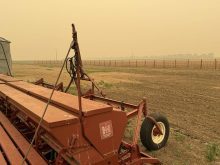Livestock feed is an economical, practical use for split or cracked great northern, kidney and pinto beans that are not suitable for the food market.
But, as with human digestion, proteins called phytohemagglutinins or lectins pose digestion and nutrition challenges for animals.
Humans soak and cook dry edible beans, which destroys these properties and improves digestion.
Institute of Agriculture and Natural Resources research at the University of Nebraska Panhandle Research and Extension Centre in Scottsbluff found that steer rations can contain limited amounts of cull beans.
Read Also

Saskatchewan puts crown land auction on hold
Auctions of Saskatchewan crown lease land are once again on hold.
“Producers can feed 10 percent beans without any adverse effects to the cattle,” said Ivan Rush, IANR animal scientist. He said rumen microorganisms apparently help break down protein inhibitors.
Rush fed 96 head of 625-pound steers three different rations in a 112-day feeding trial. Crude protein in rations of corn silage, alfalfa hay, corn and beans varied from 12.8 to 13.6 percent. Net energy was similar in each.
The three treatments were no beans, five percent and 10 percent beans. Cattle on the 10 percent bean ration had the best weight gains and feed efficiency.
“In contrast, steers fed five percent cull beans consumed more total ration than the two other groups,” Rush said.
The 10 percent ration steers gained 3.3 lb. per day and consumed 6.04 lb. of feed for each lb. gained. The five percent group gained 3.03 lb. per day and had feed efficiency of 7.18 lb. per lb. of gain.
Cattle on the no-bean control diet gained 2.98 lb. per day by eating 6.73 lb. of feed per lb. of gain.
















